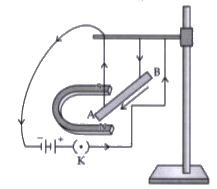Describe the activity that shows that a current-carrying conductor experiences a force perpendicular to its length and the external magnetic field. How does Fleming's left-hand rule help us to find the direction of the force acting on the current carrying conductor?
Take a small rod (AB) os aluminium an suspend it with a stand , using two connecting wires.
(i) Take a horse-shoe magnet and keep it in a way that its magnetic field is in upward direction. For this, the North Pole should be at the bottom and South Pole should be at the top. The aluminium rod should be between the two poles of this magnet.

(ii) Now connect the aluminium rod to a battery and plug key so that current flow through it from B to A.
(iii) You will notice that the aluminium rod moves towards left.
(iv) Now, change the direction of current from A to B.
(v) In this case the aluminium rod moves towards right.
In this experiment, directioon of current and direction of magnetic field are mutually perpendicular. Direction of movement of aluminium rod is perpendicular to direction of current and direction of magnetic field

Fleming.s left hand rule : If the thumb, index finger and ring finger of left hand are kept in mutually perpendicular direction then index finger shows the direction of magnetic field, ring finger shows the direction of eletric current and thumb shows the direction of deflection in current carrying conductor . By using this rule, we can easily find the direction of deflection.
Similar Questions
Explain an activity to show that a current-carrying conductor experiences a force when placed in a magnetic field.
View SolutionWhy does a current-carrying conductor experience a force when it is placed in a magnetic field ?
View SolutionMagnetic Force On A Current Carrying Conductor
View SolutionState the rule that is used to find the direction of magnetic field acting at a point near a current carrying straight conductor.
View SolutionName the rule to find the direction of force on a current-carrying conductor placed in direction perpendicular to the direction of magnetic field.
View SolutionSolenoid|Magnetic Force on Current Carrying Conductor
View SolutionHow does magnetic field due to current carrying conductor vary?
View SolutionHow does magnetic field due to current carrying conductor vary?
View SolutionThe net charge in a current-carrying conductor is zero, even then it experiences a force in a magnetic field. Why?
View Solution(a) Explain an activity to show that a current-carrying conductor experiences a force when placed in a magnetic field.
(b) State the rule which gives the direction of force acting on the conductor.
(c ) An electron moves perpendicular to a magnetic field as shown in the figure.
What would be the direction of force experienced on the electron?

View Solution
